Fabrication of Photocatalyst Composite Coatings of Cr-TiO2 by Mechanical Coating Technique and Oxidation Process
Abstract
:1. Introduction
2. Experimental
2.1. Fabrication
2.2. Characterization
2.3. Photocatalytic Activity
3. Results and Discussion
3.1. Appearance and Phase Evolution of Photocatalyst Composite Coatings
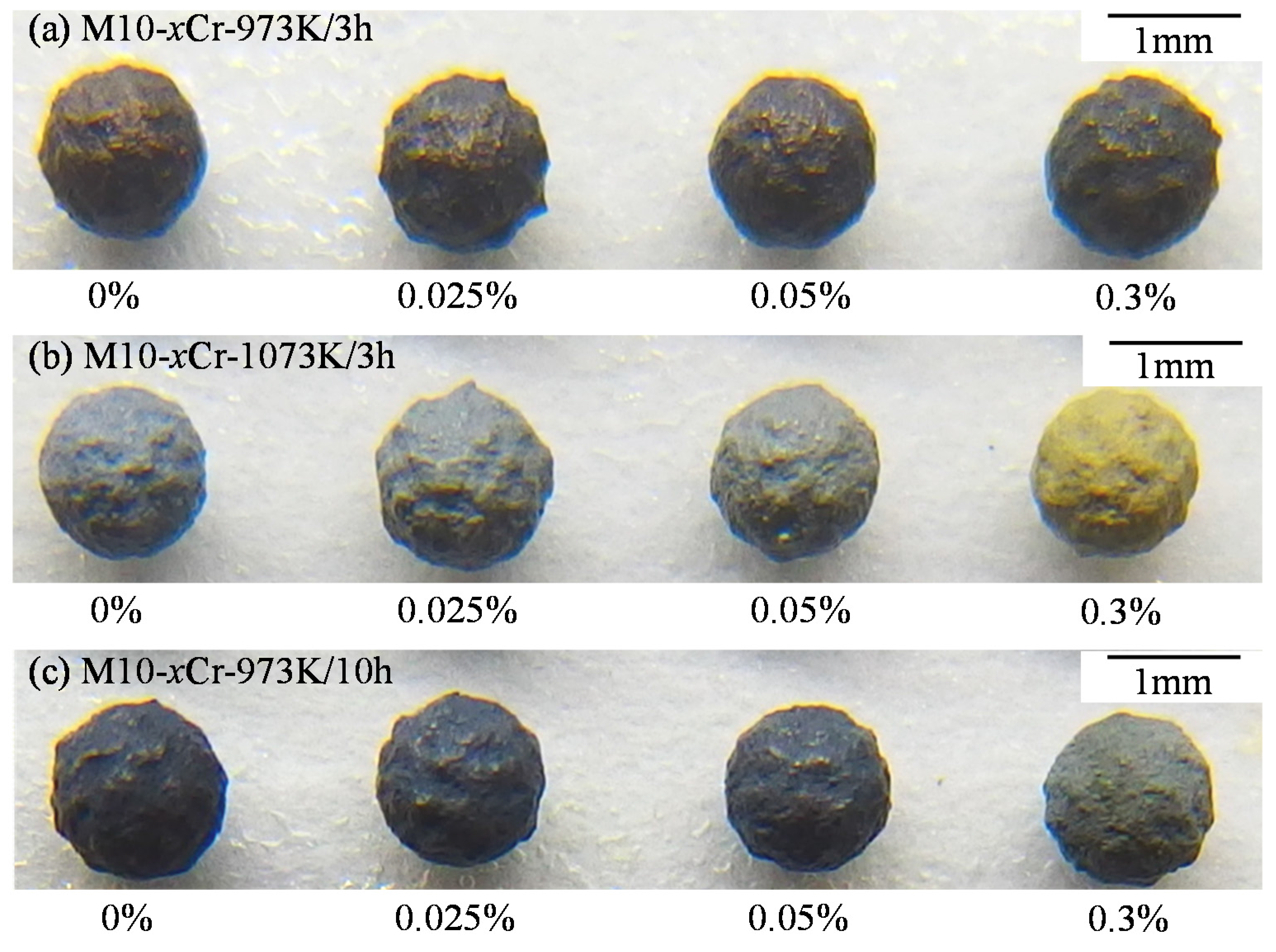

| x | y/z | ||
|---|---|---|---|
| 973 K/3 h | 103 K/3 h | 973 K/10 h | |
| 0 | 0.5 | 0.91 | 0.6 |
| 0.025 | 0.49 | 0.9 | 0.66 |
| 0.05 | 0.54 | 0.9 | 0.67 |
| 0.3 | 0.6 | 0.96 | 0.8 |
3.2. Microstructure Evolution of Photocatalyst Composite Coatings
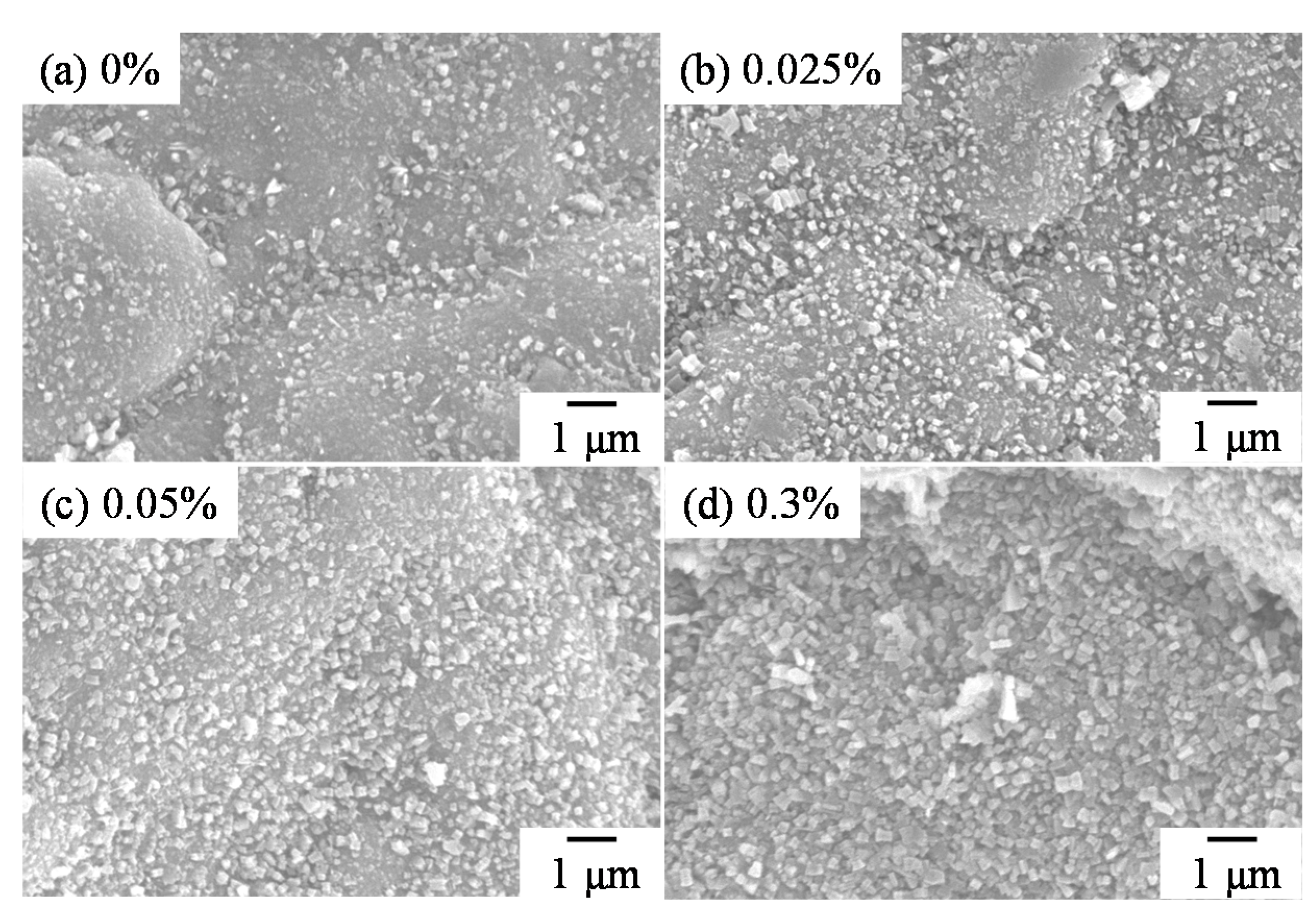
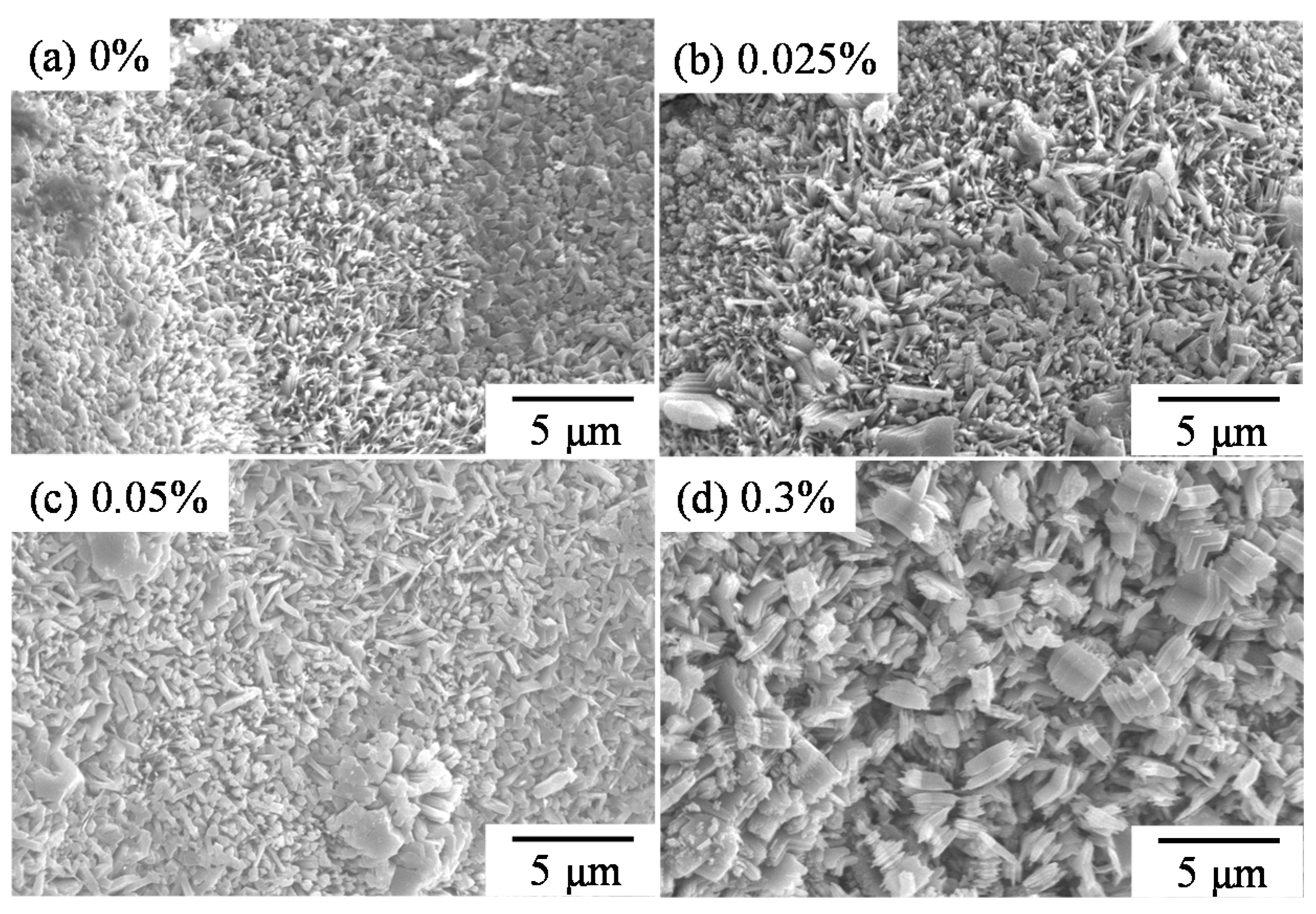
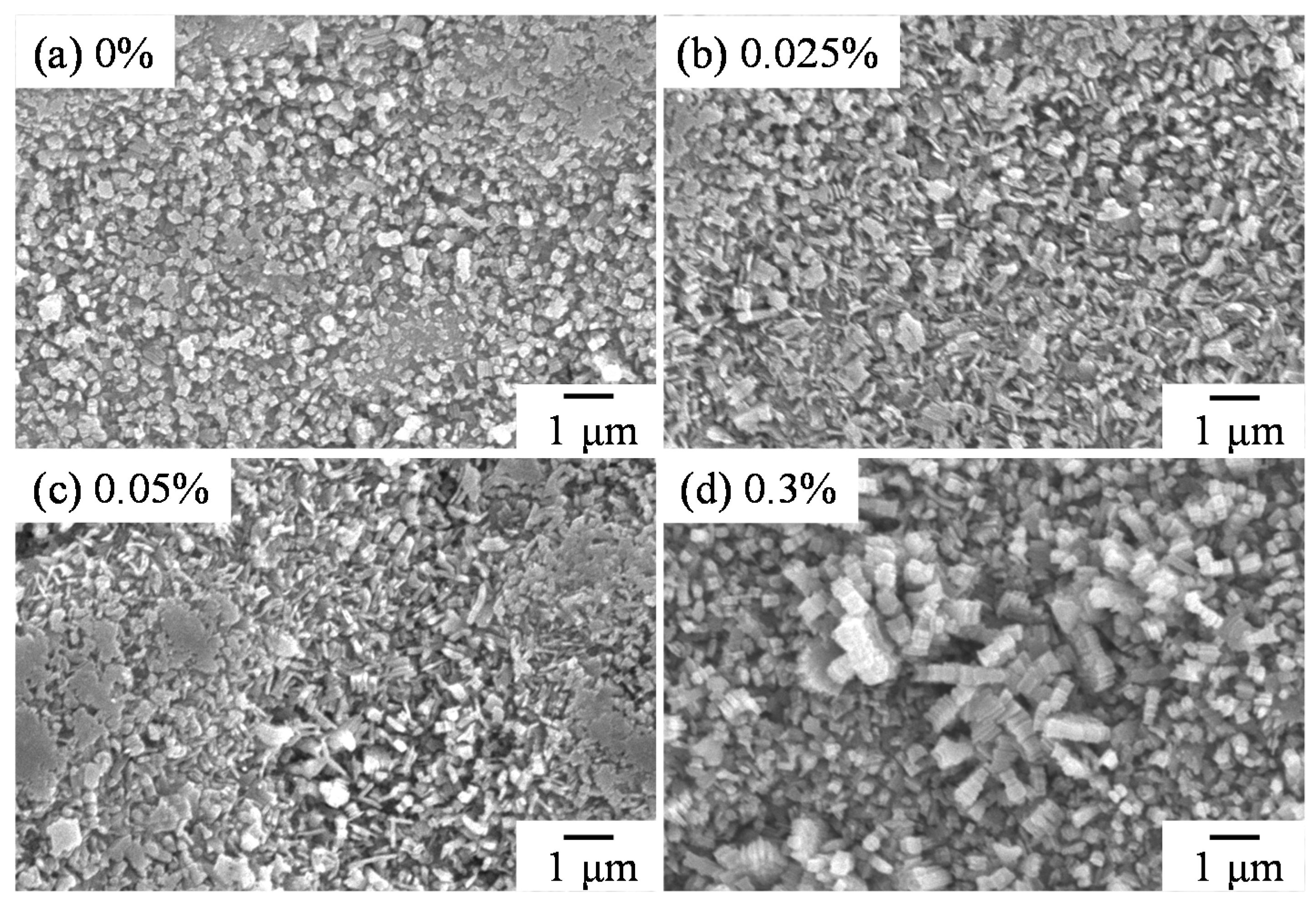
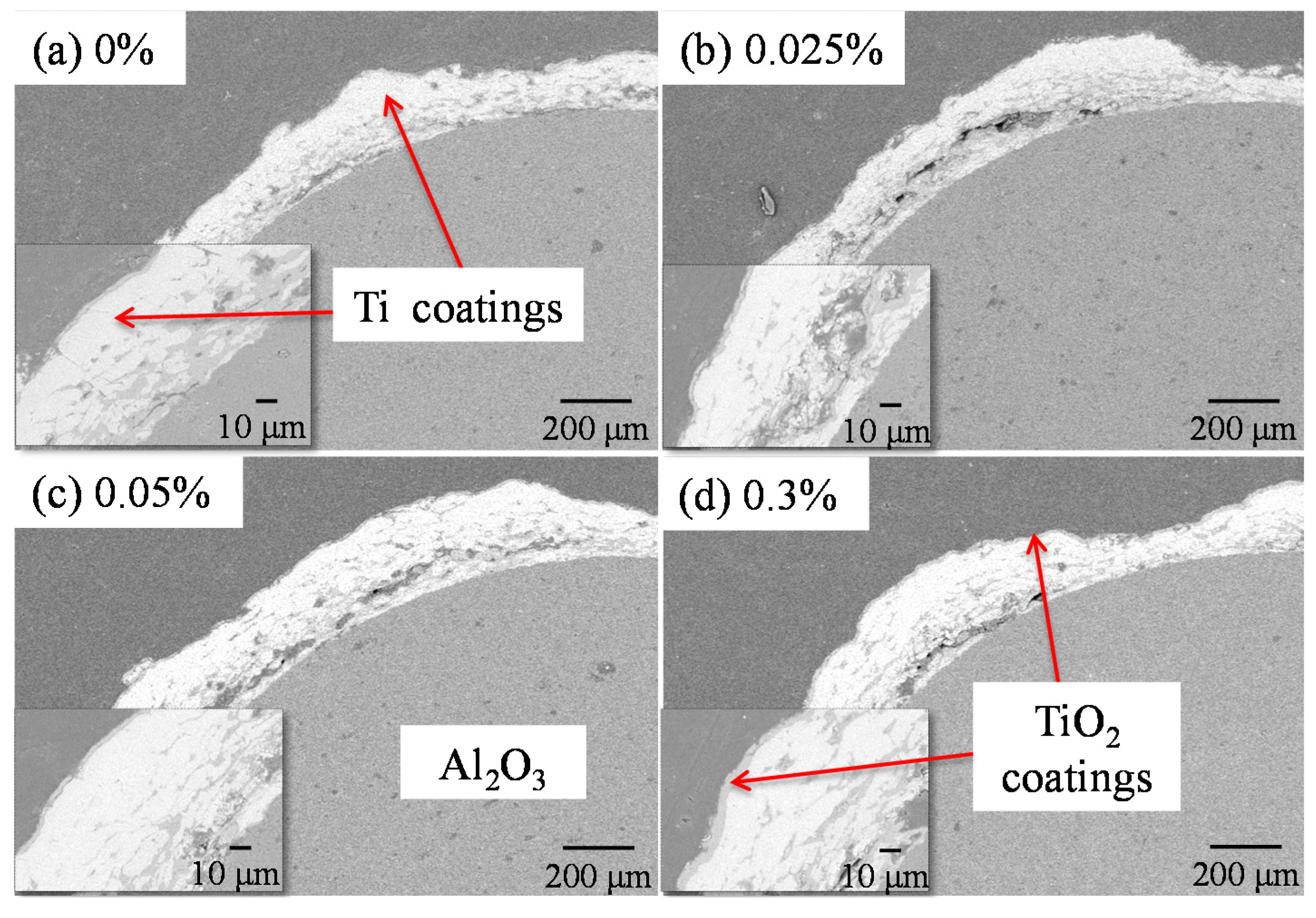
3.3. Photocatalytic Activity of Photocatalyst Composite Coatings
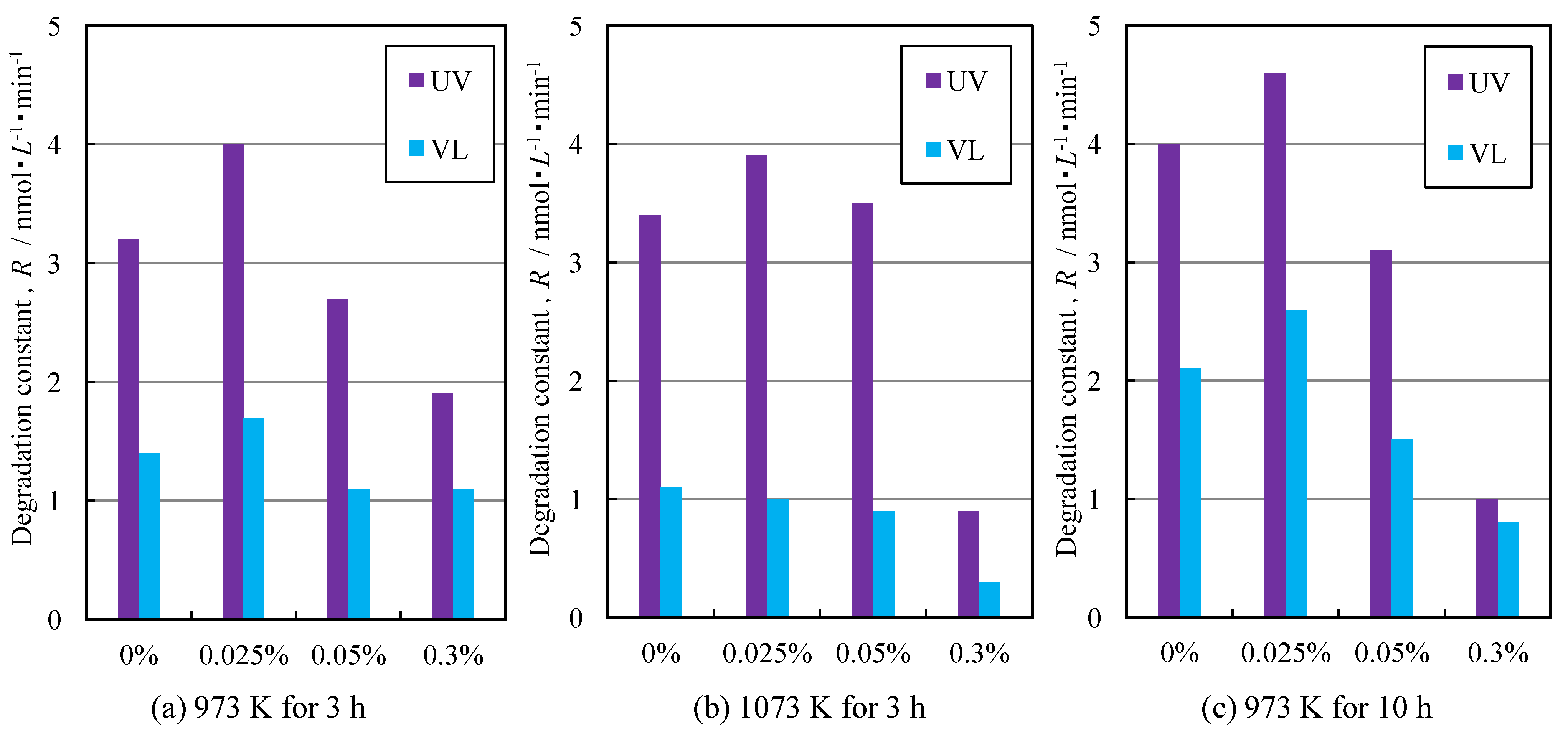
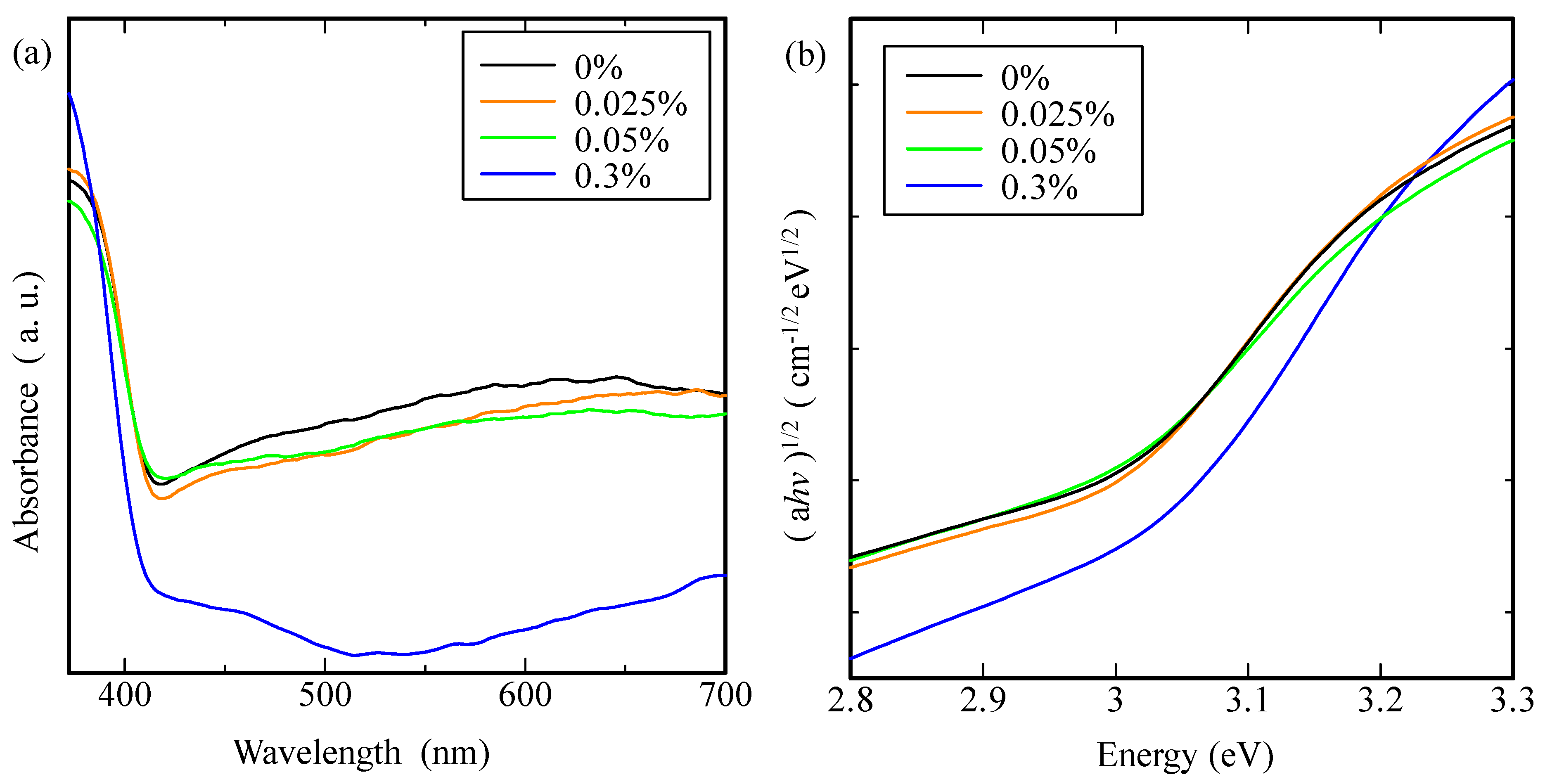
4. Conclusions
Author Contributions
Conflicts of Interest
References
- Kumar, S.G.; Devi, L.G. Review on modified TiO2 photocatalysis under UV/visible light: Selected results and related mechanisms on interfacial charge carrier transfer dynamics. J. Phys. Chem. A 2011, 115, 13211–13241. [Google Scholar] [CrossRef] [PubMed]
- Nakata, K.; Fujishima, A. TiO2 photocatalysis: Design and applications. J. Photochem. Photobiol. C 2012, 13, 169–189. [Google Scholar] [CrossRef]
- Liu, M.; Qiu, X.; Hashimoto, K.; Miyauchi, M. Cu(II) nanocluster-grafted, Nb-doped TiO2 as an efficient visible-light-sensitive photocatalyst based on energy-level matching between surface and bulk states. J. Mater. Chem. A 2014, 2, 13571–13579. [Google Scholar] [CrossRef]
- Chen, X.; Shen, S.; Guo, L.; Mao, S. Semiconductor-based photocatalytic hydrogen generation. Chem. Rev. 2010, 110, 6503–6570. [Google Scholar] [CrossRef] [PubMed]
- Chen, X.; Wang, X.; Hou, Y.; Huang, J.; Wu, L.; Fu, X. The effect of postnitridation annealing on the surface property and photocatalytic performance of N-doped TiO2 under visible light irradiation. J. Catal. 2008, 255, 59–67. [Google Scholar] [CrossRef]
- Asahi, R.; Morikawa, T.; Ohwaki, T.; Aoki, K.; Taga, Y. Visible-light photocatalysis in nitrogen-doped titanium oxides. Science 2001, 293, 269–271. [Google Scholar] [CrossRef] [PubMed]
- Akhavan, O. Lasting antibacterial activities of Ag-TiO2/Ag/a-TiO2 nanocomposite thin film photocatalysts under solar light irradiation. J. Colloid Interface Sci. 2009, 336, 117–124. [Google Scholar] [CrossRef] [PubMed]
- Akhavan, O.; Azimirad, R. Photocatalytic property of Fe2O3 nanograin chains coated by TiO2 nanolayer in visible light irradiation. Appl. Catal. A Gen. 2009, 369, 77–82. [Google Scholar] [CrossRef]
- Choudhury, B.; Choudhury, A. Dopant induced changes in structural and optical properties of Cr3+ doped TiO2 nanoparticles. Mater. Chem. Phys. 2012, 132, 1112–1118. [Google Scholar] [CrossRef]
- Li, X.; Li, F.; Yang, C.; Ge, W. Photocatalytic activity of WOx-TiO2 under visible light irradiation. J. Photochem. Photobiol. A 2001, 141, 209–217. [Google Scholar] [CrossRef]
- Yan, M.; Chen, F.; Zhang, J.; Anpo, M. Preparation of controllable crystalline titania and study on the photocatalytic properties. J. Phys. Chem. B 2005, 109, 8673–8678. [Google Scholar] [CrossRef] [PubMed]
- He, Z.; Cai, Q.; Fang, H.; Situ, G.; Qiu, J.; Song, S.; Chen, J. Photocatalytic activity of TiO2 containing anatase nanoparticles and rutile nanoflower structure consisting of nanorods. J. Environ. Sci. 2013, 25, 2460–2468. [Google Scholar] [CrossRef]
- Liu, J.; Yu, X.; Liu, Q.; Liu, R.; Shang, X.; Zhang, S.; Li, W.; Zheng, W.; Zhang, G.; Cao, H.; et al. Surface-phase junctions of branched TiO2 nanorod arrays for efficient photoelectrochemical water splitting. Appl. Catal. B 2014, 158–159, 296–300. [Google Scholar] [CrossRef]
- Zhang, J.; Xu, Q.; Feng, Z.; Li, M.; Li, C. Importance of the relationship between surface phases and photocatalytic activity of TiO2. Angew. Chem. Int. Ed. 2008, 47, 1766–1769. [Google Scholar] [CrossRef] [PubMed]
- Lu, Y.; Matsuzaka, K.; Hao, L.; Hirakawa, Y.; Yoshida, H.; Pan, F. Photocatalytic activity of TiO2/Ti composite coatings fabricated by mechanical coating technique and subsequent heat oxidation. Mater. Sci. Semicond. Process. 2013, 16, 1949–1956. [Google Scholar] [CrossRef]
- Yoshida, H.; Lu, Y.; Nakayama, H.; Hirohashi, M. Fabrication of TiO2 film by mechanical coating technique and its photocatalytic activity. J. Alloys Compd. 2009, 475, 383–386. [Google Scholar] [CrossRef]
- Hoang, S.; Guo, S.; Hahn, N.; Bard, A.; Mullins, C. Visible light driven photoelectrochemical water oxidation on nitrogen-modified TiO2 nanowires. Nano Lett. 2012, 12, 26–32. [Google Scholar] [CrossRef] [PubMed]
- Lu, X.; Wang, G.; Zhai, T.; Yu, M.; Gan, J.; Tong, Y.; Li, Y. Hydrogenated TiO2 nanotube arrays for supercapacitors. Nano Lett. 2012, 12, 1690–1696. [Google Scholar] [CrossRef] [PubMed]
- Pan, C.; Wu, J. Visible-light response Cr-doped TiO2−xNx photocatalysts. Mater. Chem. Phys. 2006, 100, 102–107. [Google Scholar] [CrossRef]
- Zhu, J.; Deng, Z.; Chen, F.; Zhang, J.; Chen, H.; Anpo, M.; Huang, J.; Zhang, L. Hydrothermal doping method for preparation of Cr3+-TiO2 photocatalysts with concentration gradient distribution of Cr3+. Appl. Catal. B 2006, 62, 329–335. [Google Scholar] [CrossRef]
- Droubay, T.; Heald, S.; Shutthanandan, V.; Thevuthasan, S.; Chambers, S.; Osterwalder, J. Cr-doped TiO2 anatase: A ferromagnetic insulator. J. Appl. Phys. 2005, 97. [Google Scholar] [CrossRef]
- Spuur, R.; Myers, H. Quantitative analysis of anatase-rutile mixtures with an X-ray diffractometer. Anal. Chem. 1957, 29, 760–762. [Google Scholar] [CrossRef]
- Hajjaji, A.; Gaidi, M.; Bessais, B.; Khakani, M. Effect of Cr incorporation on the structural and optoelectronic properties of TiO2:Cr deposited by means of a magnetron co-sputtering process. Appl. Surface Sci. 2011, 257, 10351–10357. [Google Scholar] [CrossRef]
- Carp, O.; Huisman, C.L.; Reller, A. Photoinduced reactivity of titanium dioxide. Prog. Solid State Chem. 2004, 32, 33–177. [Google Scholar] [CrossRef]
- Gennari, F.C.; Pasquevich, D.M. Enhancing effect of iron chlorides on the anatase-rutile transition in titanium dioxide. J. Am. Cream. Soc. 1999, 82, 1915–1921. [Google Scholar] [CrossRef]
- Zhang, X.; Lei, L. One step preparation of visible-light responsive Fe-TiO2 coating photocatalysts by MOCVD. Mater. Lett. 2008, 62, 895–897. [Google Scholar] [CrossRef]
- Verma, R.; Samdarshi, S.K. Correlating oxygen vacancies and phase ratio/interface with efficient photocatalytic activity in mixed phase TiO2. J. Alloys Compd. 2015, 629, 105–112. [Google Scholar] [CrossRef]
- Atitar, M.F.; Ismail, A.A.; Al-Sayari, S.A.; Bahnemann, D.; Afanasev, D.; Emeline, A.V. Mesoporous TiO2 nanocrystals as efficient photocatalysts: Impact of calcination temperature and phase transformation on photocatalytic performance. Chem. Eng. J. 2015, 264, 417–424. [Google Scholar] [CrossRef]
- Liao, S.; Mayo, W.; Pae, K. Theory of high pressure/low temperature sintering of bulk nanocrystalline TiO2. Acta. Mater. 1997, 45, 4027–4040. [Google Scholar] [CrossRef]
- Lu, Y.; Kobayashi, K.; Guan, S.; Hao, L.; Yoshida, H.; Asanuma, H.; Chen, J. Influence of oxidation process on photocatalytic activity of photocatalyst coatings by mechanical coating technique. Mater. Sci. Semicond. Process. 2015, 30, 128–134. [Google Scholar] [CrossRef]
- Zhang, H.; Banfield, J.F. Understanding polymorphic phase transformation behavior during growth of nanocrystalline aggregates: Insights from TiO2. J. Phys. Chem. B 2000, 104, 3481–3487. [Google Scholar] [CrossRef]
- Zhang, J.; Xu, Q.; Li, M.; Feng, Z.; Li, C. UV Raman spectroscopic study on TiO2. II. Effect of nanoparticle size on the outer/inner phase transformation. J. Phys. Chem. C 2009, 113, 1698–1704. [Google Scholar] [CrossRef]
- Wu, C.; Chern, J. Kinetics of photocatalytic decomposition of methylene blue. Ind. Eng. Chem. Res. 2006, 45, 6450–6457. [Google Scholar] [CrossRef]
- Habibi, M.; Hassanzadeh, A.; Mahdavi, S. The effect of operational parameters on the photocatalytic degradation of three textile azo dyes in aqueous TiO2 suspensions. J. Photochem. Photobiol. A 2005, 172, 89–96. [Google Scholar] [CrossRef]
- Wang, Y.; Liu, H.; Li, Z.; Zhang, X.; Zheng, R.; Ringer, S. Role of structural defects on ferromagnetism in amorphous Cr-doped TiO2 films. Appl. Phys. Lett. 2006, 89. [Google Scholar] [CrossRef]
- Bryan, J.; Santangelo, S.; Keveren, S.; Gamelin, D. Activation of high-TC ferromagnetism in Co2+:TiO2 and Cr3+:TiO2 nanorods and nanocrystals by grain boundary defects. J. Am. Chem. Soc. 2005, 127, 15568–15574. [Google Scholar] [CrossRef] [PubMed]
- Yin, J.; Zhao, X. Enhanced electrorheological activity of mesoporous Cr-doped TiO2 from activated pore wall and high surface area. J. Phys. Chem. B 2006, 110, 12916–12925. [Google Scholar] [CrossRef] [PubMed]
- Liu, L.; Zhao, H.; Andino, J.M.; Li, Y. Photocatalytic CO2 reduction with H2O on TiO2 nanocrystals: Comparison of anatase, rutile, and brookite polymorphs and exploration of surface chemistry. ACS Catal. 2012, 2, 1817–1828. [Google Scholar] [CrossRef]
- Luttrell, T.; Halpegamage, S.; Tao, J.; Kramer, A.; Sutter, E.; Batzill, M. Why is anatase a better photocatalyst than rutile?—Model studies on epitaxial TiO2 films. Sci. Rep. 2014, 4, 1–8. [Google Scholar] [CrossRef] [PubMed]
- Ozawa, K.; Emori, M.; Yamamoto, S.; Yukawa, R.; Yamamoto, S.; Hobara, R.; Fujikawa, K.; Sakama, H.; Matsuda, I. Electron-hole recombination time at TiO2 single-crystal surfaces: Influence of surface band bending. J. Phys. Chem. Lett. 2014, 5, 1953–1957. [Google Scholar] [CrossRef] [PubMed]
- Zhang, S.; Chen, Y.; Yu, Y.; Wu, H.; Wang, S.; Zhu, B.; Huang, W.; Wu, S. Synthesis characterizatin of Cr-doped TiO2 nanotubes with high photocatalytic activity. J. Nanopart. Res. 2008, 10, 871–875. [Google Scholar] [CrossRef]
- Tsai, C.; Teng, H. Chromium-doped titanium dioxide thin-film photoanodes in visible-light-induced water cleavage. Appl. Surface Sci. 2008, 254, 4912–4918. [Google Scholar] [CrossRef]
- Vijayalakshmi, R.; Rajendran, V. Synthesis and characterization of nano-TiO2 via different methods, Archives. Appl. Sci. Res. 2012, 4, 1183–1190. [Google Scholar]
© 2015 by the authors; licensee MDPI, Basel, Switzerland. This article is an open access article distributed under the terms and conditions of the Creative Commons Attribution license (http://creativecommons.org/licenses/by/4.0/).
Share and Cite
Guan, S.; Hao, L.; Lu, Y.; Yoshida, H.; Asanuma, H. Fabrication of Photocatalyst Composite Coatings of Cr-TiO2 by Mechanical Coating Technique and Oxidation Process. Coatings 2015, 5, 545-556. https://doi.org/10.3390/coatings5030545
Guan S, Hao L, Lu Y, Yoshida H, Asanuma H. Fabrication of Photocatalyst Composite Coatings of Cr-TiO2 by Mechanical Coating Technique and Oxidation Process. Coatings. 2015; 5(3):545-556. https://doi.org/10.3390/coatings5030545
Chicago/Turabian StyleGuan, Sujun, Liang Hao, Yun Lu, Hiroyuki Yoshida, and Hiroshi Asanuma. 2015. "Fabrication of Photocatalyst Composite Coatings of Cr-TiO2 by Mechanical Coating Technique and Oxidation Process" Coatings 5, no. 3: 545-556. https://doi.org/10.3390/coatings5030545






